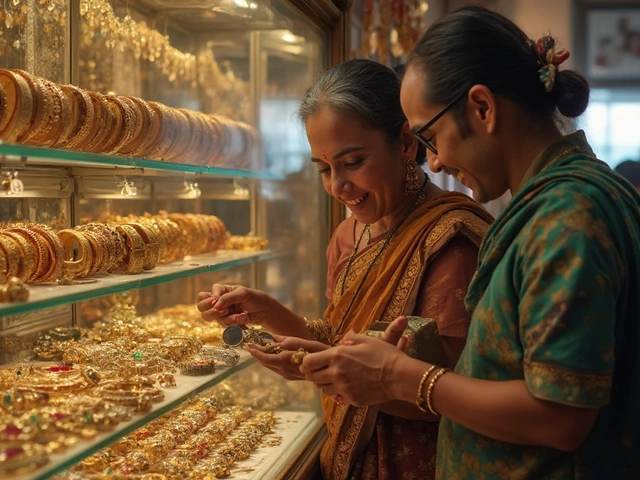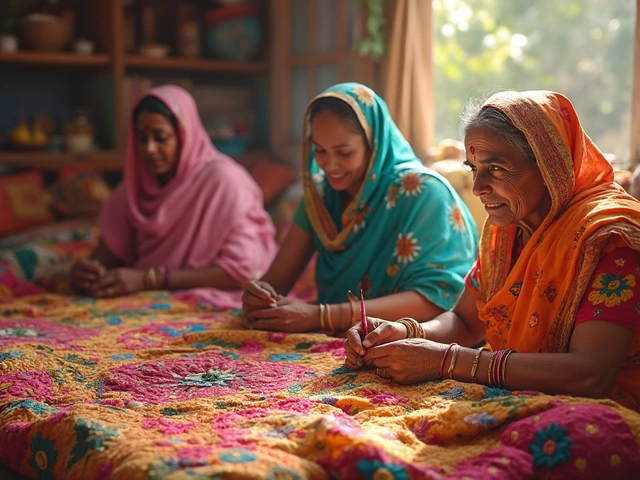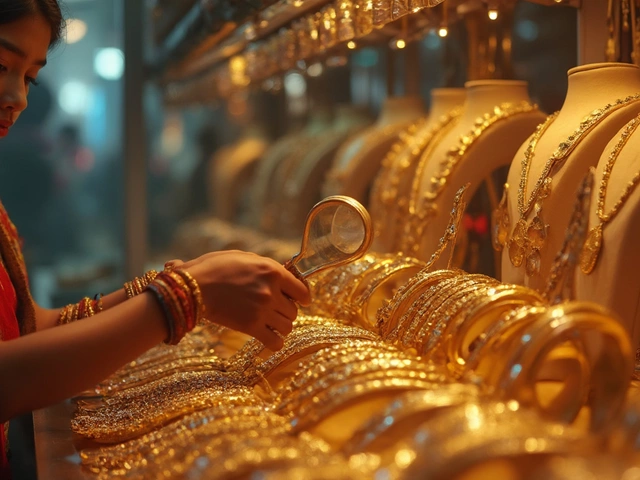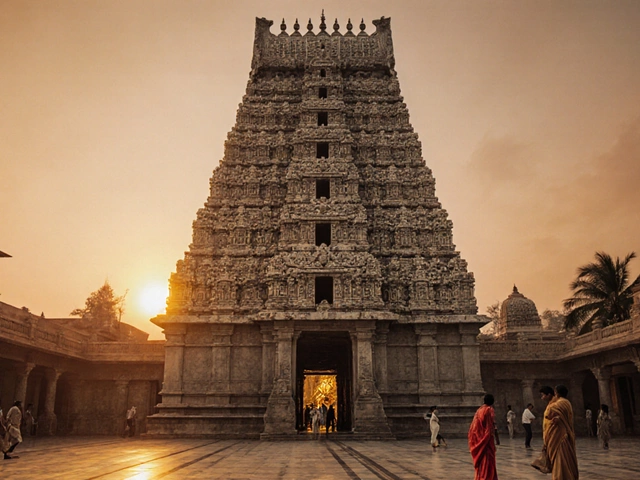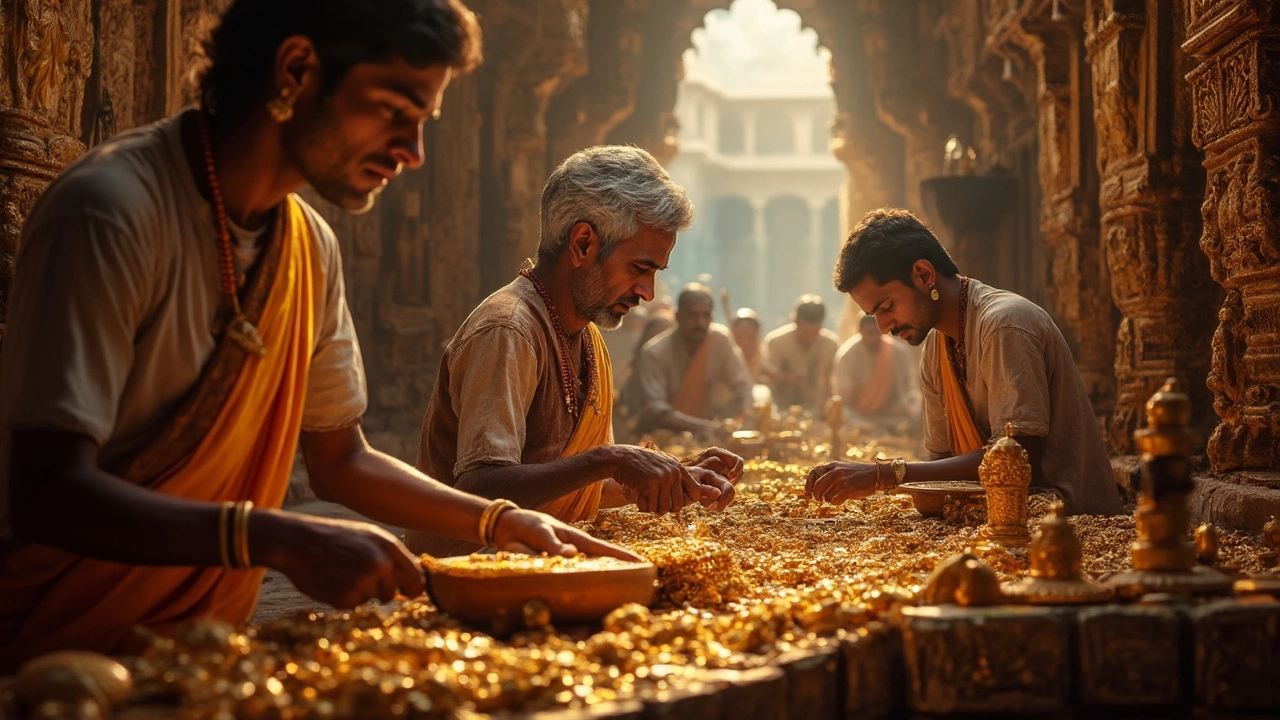
KDM gold was everywhere in Indian jewellery stores for years. If you grew up seeing chunky gold chains at weddings or shimmering temple jewellery on classical dancers, there’s a good chance it was marked as 'KDM.' But ask a jeweller today, and you’ll hear a different story: KDM gold isn’t just unpopular—it’s officially off the shelves.
Why did this happen? Was it about purity, people’s health, or just industry rules changing? And what if you inherited KDM pieces—are they safe, or should you worry? There’s a lot of confusion out there, but the answers are more practical (and surprising) than you might think. Understanding how and why KDM gold was banned—and what’s taken its place—can actually save you money and hassle when you’re buying or selling gold, especially those beautiful temple jewellery sets.
- KDM Gold: The Basics
- The Real Reason Behind the Ban
- Timeline: When KDM Gold Was Banned in India
- Impact on Temple Jewellery and Buyers
- How to Choose Safe and Authentic Gold Today
KDM Gold: The Basics
KDM gold gets its name from 'cadmium,' which was used as a solder to join pieces of gold jewelry. In short, KDM stands for 'Karat Divya Metal.' Most KDM items were marked as 22 karat gold, meaning about 91.6% pure gold mixed with other metals for strength. Cadmium, though, isn’t gold; it’s just a metal with a low melting point, which made it handy for delicate goldwork, especially solid, multi-piece designs like temple jewellery.
There’s a catch: cadmium is toxic. When jewellery artisans heat it, fumes can form, which are dangerous if inhaled. Over time, this became a problem—not just for the workers making the jewellery, but eventually, even wearers, since cadmium reacts with sweat and can cause skin irritation in some people. Despite this, KDM jewellery was super popular for decades thanks to its neat finish and good durability, especially in southern India where temple designs are intricate and heavy.
KDM gold isn’t a type of gold, but a technique of joining gold. This led to a lot of confusion for buyers who thought 'KDM' meant guaranteed purity. Here’s a quick comparison of common gold standards in Indian jewellery:
| Gold Type | Main Solder/Metal | Purity | Used In |
|---|---|---|---|
| KDM Gold | Cadmium | Usually 22K (91.6%) | Temple, Bridal Jewellery |
| Hallmarked Gold | Gold and approved alloy (no cadmium) | 18K, 22K, 24K | Modern, Temple, All Segments |
For a long time, people thought if jewellery had the 'KDM gold ban' mark, it had to be of top purity. But really, KDM just meant cadmium solder was used, which doesn’t guarantee the purity of the gold itself. That’s why experts now recommend looking for a BIS Hallmark—it's the only official proof of purity you can trust in Indian jewellery stores.
The Real Reason Behind the Ban
So what’s the deal with KDM gold? The short answer: It was banned because of purity issues and health problems linked to its manufacturing process. Let’s break it down.
KDM stood for 'Karat Divya Metal.' This method used cadmium as a solder for joining gold parts—making it super popular because it kept gold at the exact 22K purity, and the finished look was smooth and shiny. But cadmium isn’t just another metal you find in your kitchen. When workers heated cadmium, toxic fumes were released, which, over time, could cause serious health problems like lung disease, kidney damage, and even cancer for those working in jewellery workshops.
Indian government regulators started to worry. According to the Bureau of Indian Standards (BIS), tests revealed traces of cadmium in finished jewellery and the environment near manufacturing units had higher levels of toxic residue. The World Health Organization even listed cadmium as a dangerous occupational hazard. It didn’t take long for health experts to raise alarms and push for safer alternatives.
Then there’s the purity problem. You were probably sold KDM as 22-karat, but since everything depended on manual skill and local mixes, the end result wasn’t always as pure as advertised. The gold content could drop because cadmium mixed with gold during soldering, making it hard to guarantee what you were getting without expensive tests. This created confusion and made it easy for sellers to cut corners or cheat buyers.
| Key Issues With KDM Gold | Details |
|---|---|
| Cadmium Use | Toxic fumes, occupational hazards for workers |
| Gold Purity | Inconsistent karat levels, risk of getting less gold than you pay for |
| Global Health Standards | WHO and BIS flagged cadmium as dangerous, prompting a call for a ban |
The real tipping point came around 2016, when BIS standards got stricter and the Indian government officially banned the use of cadmium in jewellery making. Jewellers switched to safer soldering alloys—usually zinc or copper-based solders. These alternatives don’t give off toxic fumes and keep the gold’s purity more predictable.
Bottom line? The KDM gold ban was all about protecting workers and buyers, and making sure you get what you pay for when you’re buying temple jewellery or any gold piece. Now, only BIS hallmark gold is considered safe and legal on the market.

Timeline: When KDM Gold Was Banned in India
The government didn’t wake up one morning and just decide to ban KDM gold. It was a gradual process that built up over years. The trouble started when people realized KDM, which uses cadmium during the soldering process, could be harmful—not just for jewellers working with it, but for anyone who wore it long-term.
By around 2013, alarm bells really started ringing after medical research linked cadmium exposure to health risks like kidney damage and cancer. At the same time, customers were getting tired of mixed-up gold purity, because KDM isn’t always 22 karat pure. That’s when the Bureau of Indian Standards (BIS) and the government stepped in.
The real turning point happened in January 2017. BIS officially banned the use of cadmium in gold jewellery soldering. This is when jewellers across the country got the memo—no KDM gold ban meant no more gold labelled “KDM” (which just referred to “cadmium”). Any gold made after January 2017 had to follow the BIS hallmarking standards, which do not allow cadmium at all.
Here’s the quick timeline for you:
- Early 2010s: Health issues start getting serious attention. Jewellers begin to move away from cadmium-based soldering.
- 2016: Government regulation talks ramp up. The BIS prepares new rules for gold hallmarking.
- January 2017: The official BIS ban makes cadmium in gold jewellery illegal in India. Jewellers are told to shift to safer alloys for soldering—mostly silver or copper.
If you see “KDM” on new jewellery now, it’s probably not genuine—old stock, or even worse, a bit shady. Before shelling out for any gold, look for the BIS hallmark, which is now the gold standard for purity and safety in the Indian market.
Impact on Temple Jewellery and Buyers
The government’s ban on KDM gold didn’t just shake up the regular gold market—it hit the world of temple jewellery pretty hard. These traditional pieces are famous for their intricate handwork and religious symbolism, often crafted for South Indian brides and classical dancers. KDM gold had been the standard here for decades because its softer finish made it easier to carve detailed designs.
When the ban kicked in around 2017, jewellers had to make a fast switch. KDM was basically an alloy made using cadmium as solder, but studies confirmed that cadmium fumes could be dangerous for craftsmen, causing serious health problems over time. That was the nail in the coffin for using KDM in all jewellery, including temple collections. Even customers started getting more aware—nobody wanted gold that could be risky for workers, and purity became a much bigger deal.
The impact? Many family-run workshops had to learn new soldering techniques and adapt to BIS (Bureau of Indian Standards) hallmark gold, which uses safe alternatives like zinc instead of cadmium. That changed how some jewellery looked and felt, especially in those chunky temple sets, but it also upped the standards on purity and workmanship. Buyers now look for the BIS hallmark stamp on every gold piece—especially when buying temple jewellery, which is both an investment and a family heirloom.
For anyone holding old KDM gold or temple jewellery, don’t panic. These pieces still have value, but you might get slightly less if you try to resell compared to hallmark gold. If you’re shopping today, always:
- Ask for BIS hallmark certification
- Check purity markings (look for 22K or 916 stamped on the jewellery)
- Buy from reputable jewellers with a transparent buyback policy
The bottom line: the switch away from KDM gold modernized the industry, protected workers, and put a bigger focus on purity and buyer safety—basically, a win for everyone in the long run.

How to Choose Safe and Authentic Gold Today
If you’re shopping for gold jewellery in India now, the old 'KDM' stamp isn’t how you tell if something’s safe or real. The government replaced KDM with new rules to protect buyers from impurities and fakes. Here’s what you need to keep in mind the next time you walk into a jewellery store or scroll online listings.
The most important thing now is hallmarking. Since June 16, 2021, the Bureau of Indian Standards (BIS) made hallmarking mandatory in 256 districts, and this is spreading fast. A proper BIS hallmark is proof that your gold matches its claimed purity. You’ll see this on KDM gold ban documentation, purchase receipts, and directly stamped on jewellery.
- BIS Hallmark: Look for a BIS triangle logo, the purity in carats (like 22K or 18K), and a six-digit BIS code.
- No More KDM: If someone pushes KDM gold, walk away. Stick to hallmarked jewellery. KDM is outdated and doesn’t meet purity standards.
- Check Purity: 22K and 24K are the most common for traditional and temple jewellery, but 18K is also used for modern designs. Purity will always be marked as part of the new hallmark.
- Get a Bill: Never skip the receipt. A good bill will mention the gold purity, making charges, GST, and the BIS hallmark.
- Ask for the Assay Certificate: For big-ticket items or investment, jewellers should show BIS certification paperwork.
Here's a quick breakdown of what the typical new BIS hallmark looks like:
| Element | Example | What It Means |
|---|---|---|
| BIS logo | △ | Confirms government-approved testing |
| Purity | 22K (916) | Gold is 91.6% pure (22 karat) |
| Jeweller's mark | ABC123 | Identifies the specific jeweller |
| Assay centre mark | XXXXXX | Code of the testing lab |
If a store claims to sell temple jewellery, look closer—real gold temple designs should always have proper hallmarks now. Fake or old-style KDM marks don’t make the cut under current regulations. With gold prices rising (crossing ₹60,000 per 10 grams for 24K as of early 2025), every extra scrap of purity and authenticity counts.
Shopping at well-known chains, checking online BIS listings for certified jewellers, and cross-checking codes are steps that make sense. If you’re eyeing antique or inherited stuff, a BIS-approved centre can retest and hallmark for a small fee, so you know exactly what you’ve got.
When you choose hallmarked jewellery, you’re not just sticking to the law—you’re actually protecting your money, your health, and your peace of mind.

